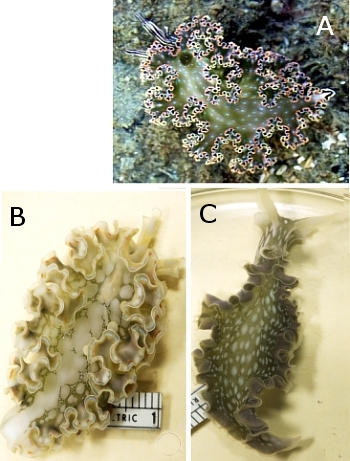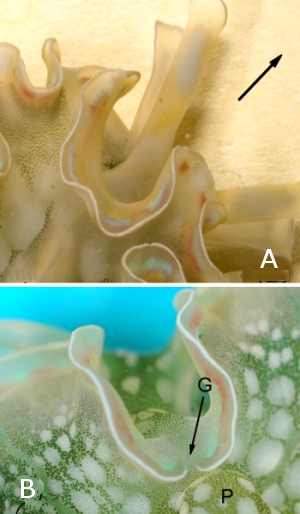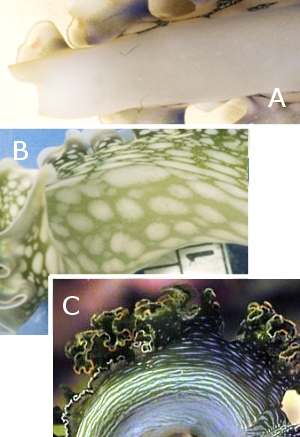Elysia clarki, E. diomedea and E. crispata
May 30, 2006
From: Bill Rudman

UPPER PHOTO: A. E. diomedea Photo: Rebecca Rissanen. B. E. crispata. C. E. clarki. Photos: S.K. Pierce.
In their recent description of Elysia clarki, the authors (Pierce et al, 2006) argue that there are many differences from E. crispata in habitat, gross and microscopic anatomy, food preferences of juveniles, sources of symbiotic chloroplasts and their localization within the digestive tubules, radular morphology, and nucleic acid sequences of mitochondrial genes.
Since these two species have been confused as one species for many years, I thought it would be useful to summarise some of the key differences between these species which can be seen by field biologists. It's not much value if you have to DNA test every specimen before you can be sure of its identity. At present E. clarki is known only from mangrove swamps, mooring canals and borrow pits in the Florida Keys, while E. crispata is considered to be found in more open reef waters throughout the Caribbean. It would be interesting now to find out whether E. clarki also has a wider distribution, perhaps in similar habitats throughout the Caribbean. For example, I suspect the animal from Belize [message #1656 ] is this new species..
Colour: Well-fed E. clarki are nearly uniformly green, interspersed with comparatively small round or oval translucent whitish spots. The green colour is present on most external surfaces including much of the head, the parapodia and the sole of the foot. In E. crispata, the green colouration is a minor part of the colour pattern, and does not extend onto the sole of the foot which is a translucent opaque whitish colour. Both species can have bluish, orange and greenish bands at the parapodial edge. Elysia diomedea, is similar to E. clarki.in the distribution of green, but while in E. clarki, the green on the sole of the foot is interspersed with rounded and oval whitish spots, in E. diomedea the translucent white regions are broken lines running parallel to the long axis of the body. E. diomedea also differs in having a characteristic pattern of black and white lines running down the rhinophores onto the head. Other differences in colour are the small blue spots scattered over the dorsum and inner walls of the parapodia, and a border of black spots, and sometimes red or orange spots, on the parapodial edge.
Parapodia: Elysia crispata is unique in having the parapodia fused in the anterior midline. In both the other species there is a small gap in the anterior midline. In both E. crispata and E. diomedea the parapodial edges are extremely folded with both primary and secondary folds. E. clarki, by comparison, has only primary folding, and often when at rest in sunlight, the parapodia will open and flatten out inot a leaf shape.
-
Pierce, S.K., Curtis, N.E., Massey, S.E., Bass, A.L., Karl, S.A. & Finney, C.M. (2006) A morphological and molecular comparison between Elysia crispata and a new species of kleptoplastic sacoglossan sea slug (Gastropoda: Opisthobranchia) from the Florida Keys, USA. Molluscan Research, 26(1): 23-38
Best wishes
Bill Rudman
LOWER PHOTOS: Right - showing anterior parapodia. Left - showing ventral colouration. A. E. crispata, B, E. clarki, C. E. diomedea


Related messages
-
Relationship of Elysia diomedea and E. crispata
From: Patrick Krug, October 6, 2008 -
Elysia clarki feeding practices
From: Adam D'Agosto, December 6, 2007 -
Elysia clarki and E. crispata in Florida
From: Skip Pierce, October 10, 2007 -
Re: Elysia crispata in Cozumel, Mexico
From: Skip Pierce, February 2, 2007 -
Re: Elysia crispata in Cozumel, Mexico
From: Jim Lyle, February 2, 2007 -
Re: Elysia crispata in Cozumel, Mexico
From: Sean Kearney, February 2, 2007 -
Re: Elysia crispata in Cozumel, Mexico
From: Skip Pierce, February 1, 2007 -
Elysia crispata in Cozumel, Mexico
From: Sean Kearney, January 29, 2007 -
Elysia clarki feeding references
From: Nicholas Curtis, January 29, 2007 -
Re: What's wrong with Elysia clarki?
From: Colin Redfern, September 9, 2006 -
Re: What's wrong with Elysia clarki?
From: Colin Redfern, September 9, 2006 -
Re: What's wrong with Elysia clarki?
From: Skip Pierce, September 8, 2006 -
Re: What's wrong with Elysia clarki?
From: Angel Valdes, September 7, 2006 -
Re: What's wrong with Elysia clarki?
From: Skip Pierce, September 1, 2006 -
Re: Damaged Elysia crispata
From: Nick Curtis, August 31, 2006 -
What's wrong with Elysia clarki?
From: Bill Rudman, August 30, 2006 -
Elysia diomedea & E. clarki in home aquarium?
From: Matt Pedersen, May 30, 2006 -
Elysia clarki breeding in the home aquarium
From: Matt Pedersen, May 30, 2006 -
A new Elysia from Florida
From: Bill Rudman, May 30, 2006 -
Lettuce Sea Slug behavior and feeding
From: Patrick Glenn, April 13, 2006 -
What to feed Elysia crispata?
From: Alexandra Ahnide, April 11, 2006 -
Elysia crispata feeding and babies
From: Willem Bermel, January 31, 2006 -
Re: Colour in Elysia (again)
From: Anne DuPont, November 7, 2005 -
Re: Lettuce sea slug - breeding success
From: Vincent, June 27, 2003 -
Lettuce sea slug - breeding success
From: Rick Hahn, May 31, 2003 -
Re: Gene transfer - Elysia crispata
From: Skip Pierce, May 5, 2003 -
Re: Algal genes in Elysia crispata
From: Philip Cromwell, May 3, 2003 -
Re: Elysia crispata and algal genes
From: Skip Pierce, May 3, 2003 -
Algal genes in Elysia crispata
From: Skip Pierce, May 2, 2003 -
Elysia crispata babies
From: Joe Bongiorno, December 30, 2002 -
Re: Baby slugs!
From: Joe Bongiorno, December 18, 2002 -
Re: Baby slugs!
From: Joe Bongiorno, December 10, 2002 -
Bifid rhinophores in Elysia crispata
From: Anna L. Bass, September 12, 2002 -
Elysia crispata? in aquaria
From: Ash, April 1, 2002 -
Re: Baby slugs! - Elysia crispata
From: Jeff Zimmerman, June 4, 2001 -
Re: Baby slugs! - Elysia crispata
From: Jeff Zimmerman, March 22, 2001 -
Baby slugs!
From: Jeff Zimmerman, March 17, 2001
